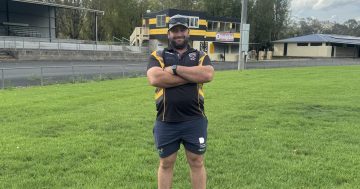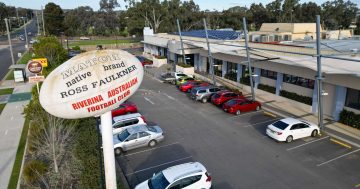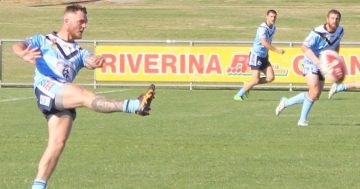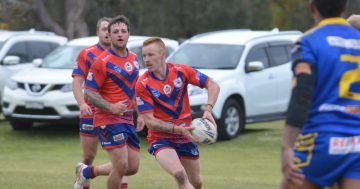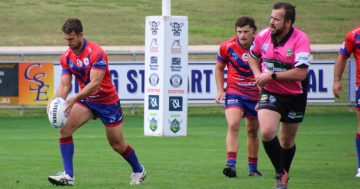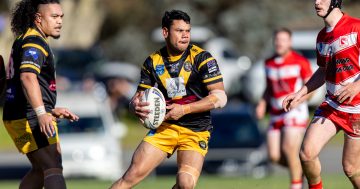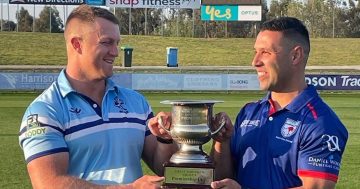
There can be big money on offer in country footy. Photo: Chris Roe.
Footy is a big business in Australia and it’s true that there are big dollars to be made, but when it comes to funding footy at a grassroots level, things can get complex and remarkably inventive.
Some country town footy teams in the Riverina have wage bills as high as $200,000, with top players earning more from kicking a ball than in their full-time jobs, while others maintain it’s all about the “pride in the guernsey”.
Playwright David Williamson summed up the quid pro quo argument in the 1977 AFL play The Club as his fictional skipper declared: “If I’m out there risking a fractured skull or a ruptured spleen for others’ amusement, I want to get paid for it!”
Indeed, rugby league was famously founded on the need for payments to compensate working-class players for tours and injuries.
While club finances and player payments are often shrouded in secrecy, Region has spoken to players and officials to gather a snapshot of those who do and those who don’t when it comes to funding sport in the Riverina.
Southern Inland Rugby Union (SIRU) proudly upholds the code’s amateur traditions, explicitly banning player payments.
SIRU chief Jack Heffernan suggests that culture, community and team pride are fundamental.
“It’s a tricky situation, but what rugby does and has historically done well is having a great culture,” he explained.
“Players can train and play where they live and they come back for the great environment.”
The incentives on offer are the pathways for both men and women to go on to Premier Rugby in Canberra, Sydney or Brisbane.
“We’ve had many players represent the Brumbies in Super Rugby,” he said.
In comparison with the oval-ball codes, soccer does not receive funding from the top of the pyramid.
The Wagga City Wanderers participate in Canberra’s CPL and, despite competing against teams boasting semi-professionals, the Wanderers have a policy of not paying players.
This season they have sought extraordinary methods of sponsorship to reduce the burden of the $600 registration, offering their players for odd jobs.

Regional soccer could have a theoretical chance of making the top tier. Photo: File.
In contrast, the region’s premier codes of Australian rules and rugby league are forced to invest heavily to attract players, and their success in fielding competitive teams has flow-on effects on the community.
Take the Osborne Tigers, the ”team without a town” bringing together many isolated farming folk every Saturday.
If you look at the struggling Wagga Kangaroos, who were historically Group 9’s premier side, poor performance leads to poor crowds and less money at the gate, and the vicious cycle begins.
That’s why they secured the best player from the best team, locking in Nathan Rose from reigning premiers Gundagai-Adelong Tigers for a deal rumoured to be about $60,000.
Captaining-coaching a top side in the premier Aussie rules or rugby league competitions carries a lot of responsibility, and talented leaders can garner anywhere between $20,000 and $60,000 a season.
Those who would rather not take on the burden of responsibility can pick up anywhere between $150 and $1500 a win, a week or a game depending on the arrangement.
A salary cap of $80,000 is in place in the Farrer League, while the RFL and Group 9 employ a player-points system to prevent the richest clubs from hoovering up all the local talent.
But things can also get creative: a star forward in the Farrer League had solar panels installed on his new house free as a reward for loyalty on top of his $15,000-a-year deal.
Similarly, a playmaker in a top Group 9 team that had been haemorrhaging players had his holidays paid for when the club president transferred a $10,000 sign-on bonus five minutes after the season’s final siren.
But gate takings and sponsorships cover only a portion of the money needed to compete for silverware in the Riverina, and the methods some clubs use to top up the war chest are incredibly inventive.
Some suggest it all comes down to “rich farmers”, but benevolent benefactors are only part of the puzzle, and arrangements rarely involve cash donations.
One clever method used by Temora Dragons RLFC, borrowing a tactic used successfully in country Victoria, is to volunteer for the harvest.
Farmers struggling to get their crops off in time receive the help of the footy club, whose players provide manpower, and a share of each hectare they get off is donated to the footy club.
In Tumut, the Pub 9s competition has been widely successful providing smaller towns without a side in Group 9 to get their day in the sun and it rewards the Tumut Blues with huge preseason gate takings that go a long way towards covering their operations.
Group 9’s invincibles, the Gundagai Tigers, have a clever arrangement where a few years back they used their funds to buy a few head of cattle. Players or administrators with farms offer up free agistment and, as the years go on, there is a flow of income that gives them the capacity to offer player reimbursements.
Definitely more effective than a meat raffle!







